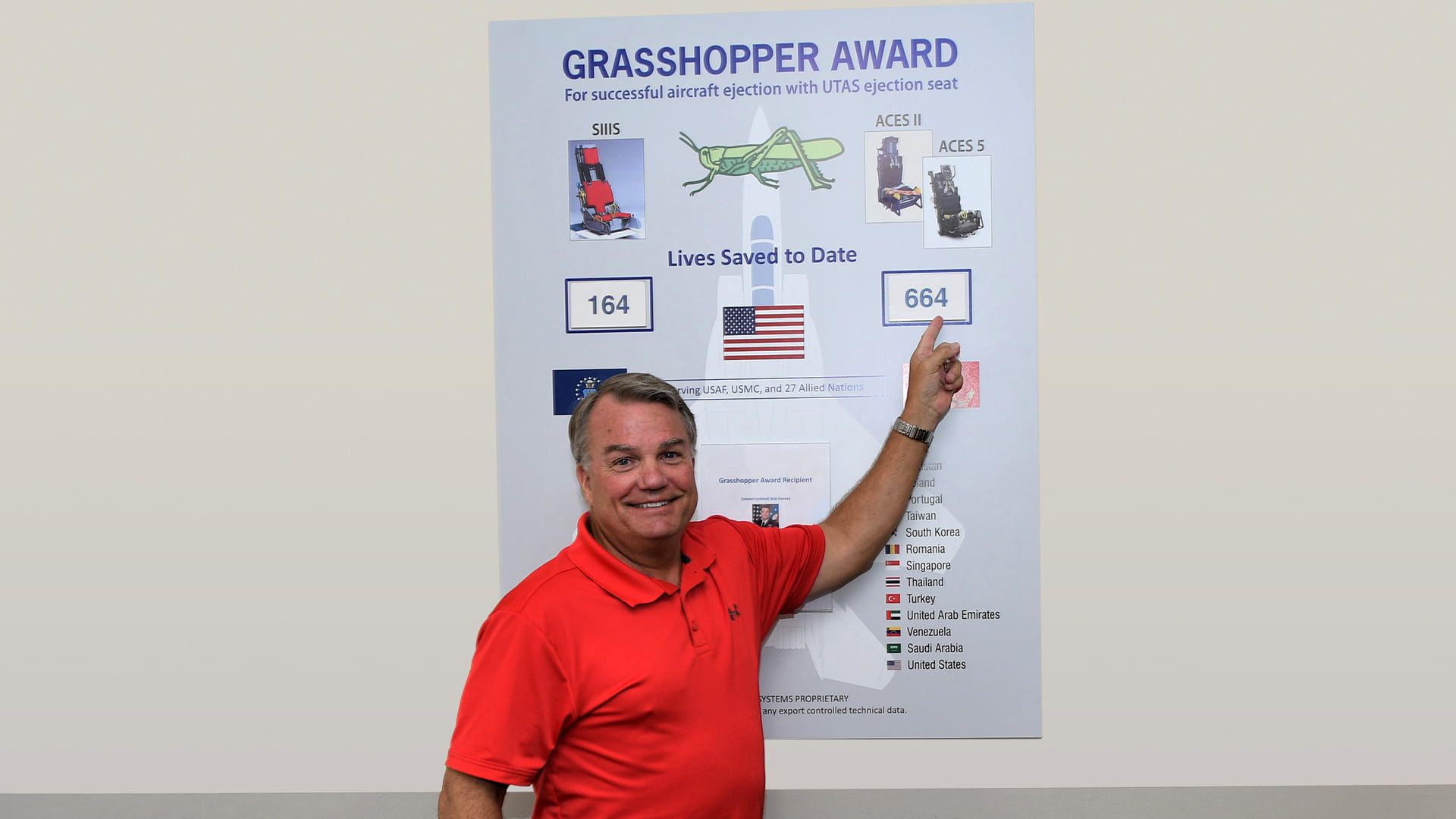October 21, 2019 - When then-U.S. Air Force (USAF) Lt. Col. Bob Harvey took off in his F-16 for a training mission at Shaw Air Force Base in South Carolina on Nov. 19, 1998, he had no idea he wouldn’t be landing as usual. Almost at the very instant he raised his landing gear, his engine immediately shut down. With no altitude to try any options, Harvey knew that ejection was his only chance for survival. After using some aircraft momentum to zoom to 157 feet altitude, he pulled the critical yellow handle to eject. Luckily for him, that handle connected to a Collins Aerospace ACES-II® ejection seat. In a split second, Harvey was successfully out of his disabled F-16 and under a good parachute to complete a safe landing. How safe was it? Safe enough that just 10 days later Harvey resumed flying.
Now retired, Col. Harvey had the opportunity to tour the facility where that seat was manufactured when he became the latest inductee into Collins Aerospace exclusive Grasshopper Club, receiving a Grasshopper Award. For four decades, Collins Aerospace and its predecessors have recognized “grasshoppers” - pilots who have successfully ejected from their military aircraft aboard an ACES-II ejection seat. Harvey is one of 664 lives that have been saved to date.
Harvey received his award at the company’s Colorado Springs ejection seat assembly area in a ceremony in front of nearly 100 Collins Aerospace Mission Systems personnel, representatives of four key ejection seat component suppliers and local government officials.
During the factory tour, Harvey expressed his admiration and appreciation to the entire integrated ejection seat team for their meticulous work to ensure the seat would perform perfectly when needed. The ACES-II, which was introduced in 1978 and has a spinal injury rate of less than 1 percent, is currently in service on more than 6,000 aircraft, including USAF’s A-10, F-15, F-16, F-22, B-1 and B-2 fleets, as well as all F-15s and F-16s worldwide.
Following the USAF’s 2017 changes to aircraft airworthiness requirements that significantly raised the safety threshold for certification of components, Collins Aerospace recently introduced the ACES 5® advanced concept ejection seat. The ACES 5 ejection seat demonstrates compliance with the Air Force’s latest MIL-HDBK-516C airworthiness standards, being the first and only seat to complete a U.S. government qualification program based on these latest requirements.
Featuring multi-platform capability for the F-15, F-16, F-22, B-1 and B-2 aircraft, ACES 5 was selected as the ejection seat for the Boeing T-X trainer aircraft.
Building on the decades-long success of the ACES-II, the ACES 5 is designed to respond to ejection challenges posed by technology advancements such as helmet-mounted devices (HMDs), as well as USAF’s expanded weight range for male and female aviators. These challenges did not exist when legacy USAF ejection seats were introduced several decades ago – thus requiring a new seat to provide adequate levels of aircrew protection. In addition to these life-saving safety improvements, ACES 5 also provides significant benefits in terms of reduced maintenance costs and increased aircraft availability.
If unfortunate events happen, it’s good to know Collins Aerospace and ACES are there for aircrew who are born to fly so they can eject safely and live to walk away. Given the opportunity to fly again with an ACES seat, Harvey told the audience during his award presentation that he would do so without the slightest hesitation.

